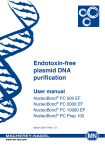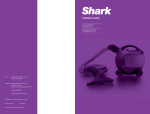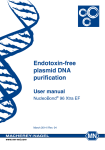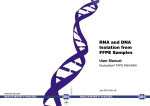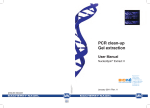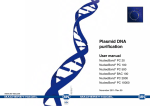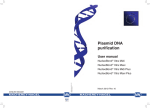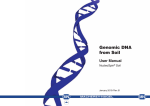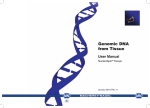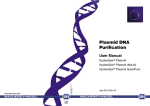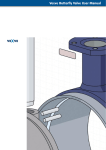Download Endotoxin-free Plasmid Purification
Transcript
Endotoxin-free Plasmid DNA User Manual NucleoBond® PC 500 EF NucleoBond® PC 2000 EF NucleoBond® PC 10000 EF A025753 R11en1/0/8/07.10 PD Printed in Germany NucleoBond® PC Prep 100 www.mn-net.com MACHEREY-NAGEL July 2010 / Rev. 11 MACHEREY-NAGEL MACHEREY-NAGEL MN EN ISO 9001: 2008 CERTIFIED Endotoxin-free Plasmid Purification (Maxi, Mega, Giga, Preparative scale) Protocol-at-a-glance (Rev. 11) Maxi Mega Giga Preparative scale (AX 500) (AX 2000) (AX 10000) (AX Prep 100) 4,500 – 6,000 x g 15 min at 4°C 4,500 – 6,000 x g 15 min at 4°C 4,500 – 6,000 x g 15 min at 4°C 4,500 – 6,000 x g 15 min at 4°C Buffer S1-EF 12 mL 40 mL 120 mL 1000 mL Buffer S2-EF 12 mL < 5 min at RT 40 mL < 5 min at RT 120 mL < 5 min at RT 1000 mL < 3 min at RT Buffer S3-EF 12 mL 5 min at 0 °C 40 mL / 120 mL / 1000 mL 25 min at 0 °C Buffer N2-EF 5 mL Buffer N2-EF 25 mL Buffer N2-EF 100 mL Buffer N2-EF 900 mL Folded Filter Bottle Top Filter Type 1 Bottle Top Filter Type 2 1st Sieving Fabric 20 min 5 min 5 min Load cleared lysate onto the column Load cleared lysate onto the column Load cleared lysate onto the column Load cleared lysate onto the column Buffer N3-EF 2 x 24 mL Buffer N3-EF 1 x 60 mL 2 x 40 mL Buffer N3-EF 4 x 150 mL Buffer N3-EF 900 mL Buffer N4-EF 2 x 12 mL Buffer N4-EF 60 mL Buffer N4-EF 3 x 130 mL Buffer N4-EF 1900 mL Buffer N5-EF 15 mL Buffer N5-EF 25 mL Buffer N5-EF 100 mL Buffer N5-EF 470 – 600 mL Isopropanol 11 mL Isopropanol 18 mL Isopropanol 70 mL Isopropanol 0.7 vol ≥ 15,000 x g 30 min at 12 °C ≥ 15,000 x g 30 min at 12 °C ≥ 15,000 x g 30 min at 12 °C ≥ 15,000 x g 60 min at 12 °C 70 % ethanol 5 mL 70 % ethanol 7 mL 70 % ethanol 10 mL 70 % ethanol 25 mL ≥ 15,000 x g 10 min at RT ≥ 15,000 x g 10 min at RT ≥ 15,000 x g 10 min at RT ≥ 15,000 x g 20 min at RT 10 – 20 min 30 – 60 min 30 – 60 min 60 min Appropriate volume of TE-EF or H2O-EF Appropriate volume of TE-EF or H2O-EF Appropriate volume of TE-EF or H2O-EF Appropriate volume of TE-EF or H2O-EF 1 Cultivate and harvest bacterial cells 2 Cells lysis 3 4 Equilibration of the column Clarification of the lysate 5 Binding 6 Washing 7 8 9 10 2nd Folded Filters Elution Precipitation Wash and dry DNA pellet Reconstitute DNA MACHEREY-NAGEL GmbH & Co. KG • Neumann-Neander-Str. 6-8 • D-52355 Düren • Germany Tel.: +49 (0) 24 21 969 270 • www.mn-net.com • e-mail: [email protected] MN Endotoxin-free Plasmid DNA Table of contents 1 2 3 Components 4 1.1 Kit contents 4 1.2 Reagents and equipment to be supplied by user 6 Introduction 7 2.1 Why the removal of endotoxins? 7 2.2 About this User Manual 7 Product description 8 3.1 The basic principle 8 3.2 Kit specifications 8 3.3 Convenient stopping points 9 3.3 Filtration of the lysate 10 3.4 Analytical check (refers only to PC Prep 100) 11 3.5 Elution procedure 14 3.6 Disposal of column resin (PC Prep 100 only) 14 4 Storage conditions and preparation of working solutions 15 5 Safety instructions – risk and safety phrases 17 6 Growing of bacterial cultures 18 6.1 General considerations 18 6.2 Selection of culture media 18 6.3 Difficult-to-lyse strains 18 6.4 Chloramphenicol amplification of low-copy plasmids 19 7 8 NucleoBond® EF plasmid purification 20 7.1 General procedure 20 7.2 Endotoxin-free plasmid purification (Maxi, Mega, Giga) 20 7.3 Plasmid purification (preparative scale) 24 Appendix 28 8.1 Determination of DNA yield and quality 28 8.2 Troubleshooting 28 8.3 Ordering information 35 8.4 References 36 8.5 Product use restriction / warranty 36 MACHEREY-NAGEL – 07 / 2010, Rev. 11 3 Endotoxin-free Plasmid DNA 1 Components 1.1 Kit contents NucleoBond® PC 500 EF NucleoBond® PC 2000 EF NucleoBond® PC 10000 EF 10 preps 5 preps 5 preps REF 740550 740549 740548 Resuspension Buffer S1-EF 150 mL 2 x 125 mL 3 x 250 mL Lysis Buffer S2-EF 150 mL 250 mL 750 mL Neutralization Buffer S3-EF 150 mL 250 mL 750 mL Equilibration Buffer N2-EF 100 mL 150 mL 600 mL Wash Buffer N3-EF 3 x 200 mL 2 x 400 mL 200 mL 3 x 1000 mL Wash Buffer N4-EF 2 x 150 mL 400 mL 3 x 750 mL Elution Buffer N5-EF 200 mL 150 mL 600 mL Redissolving Buffer TE-EF 30 mL 30 mL 30 mL H2O-EF (for 70 % ethanol)* 30 mL 30 mL 30 mL H2O-EF (for redissolving) 30 mL 30 mL 30 mL RNase A (lyophilized)* 15 mg 2 x 12 mg 3 x 25 mg NucleoBond® AX 500 / 2000 / 10000 Columns 10 5 5 NucleoBond® Folded Filters 10 - - NucleoBond® Bottle Top Filters (Type 1 or 2) - 5 Type 1 5 Type 2 Plastic Washers 5 5 - User Manual 1 1 1 * For preparation of working solutions and storage conditions see section 4. 4 MACHEREY-NAGEL – 07 / 2010, Rev. 11 Endotoxin-free Plasmid DNA 1.1 Kit contents continued NucleoBond® PC Prep 100 1 prep REF 740594 Resuspension Buffer S1-EF 1000 mL Lysis Buffer S2-EF 1000 mL Neutralization Buffer S3-EF 1000 mL Equilibration Buffer N2-EF 1000 mL Wash Buffer N3-EF 1000 mL Wash Buffer N4-EF 2 x 1000 mL Elution Buffer N5-EF 1000 mL Redissolving Buffer TE-EF 2 x 30 mL H2O-EF (for 70 % ethanol)* 2 x 30 mL H2O-EF (for redissolving) 2 x 30 mL RNase A (lyophilized)* 100 mg NucleoBond® AX Prep 100 Column 1 NucleoBond® AX 100 Columns 3 Sieving Fabric 3 NucleoBond® Folded Filters (Type 1 and 2) User Manual 2x5 1 * For preparation of working solutions and storage conditions see section 4. MACHEREY-NAGEL – 07 / 2010, Rev. 11 5 Endotoxin-free Plasmid DNA 1.2 Reagents and equipment to be supplied by user Reagents • Isopropanol (room-temperatured) • 96 – 100% ethanol (room-temperatured) • Ice Equipment 6 • Standard microbiological equipment for growing and harvesting bacteria (e.g., inoculating loop, culture tubes and flasks, 37° C shaking incubator, and centrifuge with rotor and tubes or bottles for harvesting cells) • Refrigerated centrifuge capable of reaching ≥ 20,000 x g with rotor for the appropriate centrifuge tubes or bottles • Centrifugation tubes or vessels with suitable capacity for the volumes specified in the respective protocol • NucleoBond® Rack Large (see ordering information) or equivalent holder • Peristaltic pump (for NucleoBond® PC Prep 100 only) MACHEREY-NAGEL – 07 / 2010, Rev. 11 Endotoxin-free Plasmid DNA 2 Introduction 2.1 Why the removal of endotoxins? Endotoxins (lipopolysaccharide, LPS) are a major component of the Gram-negative bacterial cell wall. The LPS molecules are extremely potent stimulators of the mammalian immune system, and a number of mechanisms exist to detect LPS and to respond to the presence of either this class of molecules or Gram-negative bacteria. LPS is a common contaminant of plasmid DNA preparations grown in E. coli. The negative charges associated with lipid A and the inner core of LPS cause the LPS molecules to behave like DNA on anion-exchange chromatography resins. Therefore, standard NucleoBond® procedures as well as other chromatography techniques lead to slightly contaminated plasmid DNA. For this reason MACHEREY-NAGEL developed a specific procedure that reduces endotoxins to a very low level (patent pending). Due to the fact that the buffer solutions are modified, the working procedure for endotoxin-free plasmid preparation is identical to the standard protocol. 2.2 About this User Manual Experienced users who are performing the purification of high-copy plasmids using a NucleoBond® Plasmid purification kit may refer to the Protocol-at-a-glance instead of this User Manual. The Protocol-at-a-glance is designed to be used only as a supplemental tool for quick referencing while performing the purification procedure. First-time users are strongly advised to read this User Manual. Each procedural step in the protocols of this manual is arranged like the following example: 1 Maxi Mega Giga (AX 500) (AX 2000) (AX 10000) Carefully resuspend the pellet of bacterial cells in Buffer S1-EF + RNase A. Please see section 6.3 regarding difficult-to-lyse strains. 12 mL 40 mL 120 mL For NucleoBond® PC 500 EF preparations refer to the buffer volumes and incubation times given in the white boxes. For Mega and Giga preparations refer to the grey and black boxes, respectively. The name of the buffer is highlighted in bold type. For example in a NucleoBond® PC 500 EF preparation you are requested to resuspend the pelleted cells in 12 mL of Buffer S1-EF. MACHEREY-NAGEL – 07 / 2010, Rev. 11 7 Endotoxin-free Plasmid DNA 3 Product description 3.1 The basic principle NucleoBond® EF kits employ a modified alkaline / SDS lysis procedure to prepare the bacterial cell pellet for plasmid purification. Both chromosomal and plasmid DNA are denatured under these alkaline conditions. Potassium acetate is then added to the denatured lysate, which causes the formation of a precipitate containing chromosomal DNA and other cellular compounds. The potassium acetate buffer also neutralizes the lysate. Plasmid DNA, which remains in solution, can revert to its native supercoiled structure. After equilibrating the appropriate NucleoBond® Column with equilibration buffer, plasmid DNA is bound to the anion-exchange resin and finally eluted after efficient washing of the column. Endotoxins are removed by Buffer N3-EF. After precipitation of the eluted DNA it can easily be dissolved in Buffer TE-EF or H2O-EF for further use. 3.2 Kit specifications • NucleoBond® EF kits contain NucleoBond® Columns, appropriate buffers, and RNase A. Kits are available for the following column sizes: Maxi (PC 500 EF), Mega (PC 2000 EF), Giga (PC 10000 EF), and preparative scale (PC Prep 100). • The protocols are suitable for purifying endotoxin-free plasmids with < 0.1 EU / µg. • NucleoBond® Columns are polypropylene columns containing NucleoBond® AX Silica Resin packed between two inert filter elements. The columns are available in several sizes to accommodate a wide range of purification needs (see Table 1). Table 1: Kit specifications at a glance PC 500 EF PC 2000 EF Recomm. medium PC 10000 EF PC Prep 100 LB 30 – 150 mL 150 – 500 mL 500 mL – 2 L Culture volume 5 – 20 L Max. pellet wet weight 0.75 g 2.5 g 10 g 90 g Binding capacity 500 µg 2 mg 10 mg 100 mg < 0.1 EU / µg Endotoxin level Transfection studies, gene therapy Applications Time / prep 8 100 min / 2 preps 150 min / 2 preps 180 min / 2 preps MACHEREY-NAGEL – 07 / 2010, Rev. 11 20 h / prep Endotoxin-free Plasmid DNA • NucleoBond® PC EF / Prep 100 kits allow the purification of DNA that fulfills the following criteria: Table 2: Criteria Parameter Method Criterion Agarose gel Photo documentation > 90 % ccc HPLC Agarose gel < 50 µg / mg HPLC Southern Blot / PCR < 50 µg / mg Endotoxin LAL test < 0.1 EU / µg Protein Bradford < 10 µg / mg A260/A280 UV spectrum 220 – 320 nm 1.80 – 1.95 normal Structural integrity RNA + ssDNA Chrom. DNA Purity • All NucleoBond® Columns are resistant to organic solvents such as alcohol, chloroform, and phenol and are free of DNase and RNase. • NucleoBond® AX Resin can be used over a wide pH range, from pH 2.5 – 8.5, and can remain in contact with buffers for up to three hours without any change in its chromatographic properties. After three hours, nucleic acids will begin to elute at increasingly lower salt concentrations. Normally, the resin remains functional in buffers containing up to 2 M salt. It remains intact in the presence of denaturing agents like formamide, urea, or common detergents such as Triton X-100 and NP-40. 3.3 Convenient stopping points Cell pellets can easily be stored for several months at - 20 °C. Cleared lysates can be kept on ice or at 4 °C for several days. For optimal performance the column purification should not be interrupted. However, the columns can be left unattended for several hours since the columns do not run dry. This might cause only small losses in DNA yield. The eluate can be stored for several days at 4 °C. Note that the eluate should be warmed up to room temperature before precipitating the DNA to avoid co-precipitation of salt. MACHEREY-NAGEL – 07 / 2010, Rev. 11 9 Endotoxin-free Plasmid DNA 3.3 Filtration of the lysate After alkaline lysis, the solution has to be clarified from, for example, the cell debris through the supplied NucleoBond® Folded Filters or NucleoBond® Bottle Top Filters in order to prevent clogging of the column. • For the NucleoBond® AX 2000 (Mega) and AX 10000 (Giga) Column, use the supplied vacuum operated NucleoBond® Bottle Top Filters for filtration of the lysate. The bottle top filters (Figure 1) make the separation of the bacterial lysate and SDS precipitate easy, quick, and convenient. Adjust the bottle top filter to a suitable flask (e.g., Schott), load the bacterial lysate, and apply the vacuum. After 5 min the solution will have passed through. Load the resulting clear lysate onto the corresponding NucleoBond® AX Column and discard the bottle top filter. Figure 1: Correct use of the NucleoBond® Bottle Top Filter • For the NucleoBond® AX 500 Column use the supplied NucleoBond® Folded Filters for filtration of the lysate (Figure 2). Folded filters are designed to eliminate the centrifugation step after alkaline lysis for plasmid isolation. The filters completely remove SDS and precipitate cellular debris from plasmid samples. For correct use please follow the instructions given in step 4 of the corresponding protocol. Figure 2: Correct use of the NucleoBond® Folded Filter, NucleoBond® Column placed in a Plastic Washer 10 MACHEREY-NAGEL – 07 / 2010, Rev. 11 Endotoxin-free Plasmid DNA 3.4 Analytical check (refers only to PC Prep 100) Before starting the NucleoBond® PC Prep 100 purification, we recommend checking the fermented cell material by purifying the plasmid DNA from 20 mL and 40 mL of culture on a NucleoBond® AX 100 Column (supplied). Follow the instructions of the attached protocol. From the yield resulting from 20 mL and 40 mL fermentation broth using a NucleoBond® AX 100 Column, the total yield of the NucleoBond® Prep 100 procedure can be estimated. If necessary, the culture volume can be adapted accordingly with respect to a maximum pellet weight of 90 g and a maximum binding capacity of 100 mg (also see section 3.2). In the case that a 20 mL fermentation broth (high copy plasmid) already results in 60 – 100 µg of plasmid DNA, yields obtained from a 40 mL fermentation broth will be invalid because the NucleoBond® AX 100 Column (Midi prep) has been overloaded. Take the yields obtained from the 20 mL fermentation broth as a basis for the calculation of how much fermentation broth can be used for the NucleoBond® AX Prep 100 Column (preparative scale). Midi (AX 100) 1 Harvest bacteria Harvest bacteria from 20 and 40 mL fermentation broth by centrifugation at 4,500 – 6,000 x g for 15 min at 4 °C. 2 Cell lysis Carefully resuspend the pellet of bacterial cells in Buffer S1-EF + RNase A. Please see section 6.3 regarding difficult-to-lyse strains. 4 mL Add Buffer S2-EF to the suspension. Mix gently by inverting the tube 6 – 8 times. Incubate the mixture at room temperature (18 – 25 °C) for 2 – 3 min (max. 5 min). Do not vortex, as this will release contaminating chromosomal DNA from cellular debris into the suspension. 4 mL MACHEREY-NAGEL – 07 / 2010, Rev. 11 11 Endotoxin-free Plasmid DNA Midi (AX 100) Add precooled Buffer S3-EF (4 °C) to the suspension. Immediately mix the lysate gently by inverting the flask 6 – 8 times until a homogeneous suspension containing an off-white flocculate is formed. Incubate the suspension on ice for 5 min. 4 mL 3 Equilibration of the column Equilibrate a NucleoBond® AX 100 (Midi) Column with Buffer N2-EF. Allow the column to empty by gravity flow. Discard flow-through. 2.5 mL 4 Clarification of the lysate Clear the bacterial lysate by following EITHER option 1 or option 2 as described below. This step is extremely important; excess precipitate left in suspension may clog the NucleoBond® Column in later steps. Option 1: Centrifuge the suspension. Centrifuge at > 12,000 x g for the minimum time indicated below at 4 °C. If the suspension contains residual precipitate after the first centrifugation, repeat this step. 25 min Option 2. Filter the suspension. Place a NucleoBond® Folded Filter (not provided) in a small funnel for support, and prewet the filter with a few drops of Buffer N2-EF or sterile deionized H2O. Load the lysate onto the wet filter and collect the flow-through 5 Binding Load the cleared lysate from step 4 onto the NucleoBond® Column. Allow the column to empty by gravity flow. Optional: You may want to save all or part of the flow-through for analysis. 12 MACHEREY-NAGEL – 07 / 2010, Rev. 11 Endotoxin-free Plasmid DNA Midi (AX 100) 6 Washing Wash the column with Buffer N3-EF. Discard flow-through. 10 mL Wash the column with Buffer N4-EF. Discard flow-through. 5 mL 7 Elution Elute the plasmid DNA with Buffer N5-EF. We recommend precipitating the eluate as soon as possible (step 8). Nevertheless, the eluate can be stored in closed vials on ice for several hours. In this case the eluate should be prewarmed to room temperature before the plasmid DNA is precipitated. 5 mL 8 Precipitation Add room-temperature isopropanol to precipitate the eluted plasmid DNA. Mix carefully and centrifuge at ≥ 15,000 x g for 30 min at 12 °C. Carefully discard the supernatant. 3.5 mL 9 Wash and dry DNA pellet Add room-temperature endotoxin-free 70 % ethanol to the pellet. Vortex briefly and centrifuge at ≥ 15,000 x g for 10 min at room temperature (18 – 25 °C). For preparation of endotoxin-free 70 % ethanol refer to section 4. 2 mL MACHEREY-NAGEL – 07 / 2010, Rev. 11 13 Endotoxin-free Plasmid DNA Midi (AX 100) Carefully remove ethanol from the tube with a pipette tip. Allow the pellet to dry at room temperature (18 – 25 °C), at least for the indicated time. Drying for longer periods will not harm the quality of the plasmid DNA but over-drying may render the DNA less soluble. 5 – 10 min 10 Reconstitute DNA Dissolve pellet in an appropriate volume of Buffer TE-EF or H2O-EF. Depending on the type of centrifugation tube, dissolve under constant spinning in a sufficient amount of buffer for 10 – 60 min (3D-shaker). Determine plasmid yield by UV spectrophotometry. Confirm plasmid integrity by agarose gel electrophoresis. 3.5 Elution procedure Elution is carried out into a new tube with the volume of elution buffer indicated in the corresponding protocol. The plasmid DNA is precipitated by the addition of roomtemperature (18 – 25 °C) isopropanol. Do not let the plasmid DNA solution drop into a vial with isopropanol, because this leads to spontaneous co-precipitation of salt. Only use room-temperature (18 – 25 °C) isopropanol to prevent spontaneous coprecipitation of salt. 3.6 Disposal of column resin (PC Prep 100 only) Rinse the NucleoBond® AX Prep 100 Column with 350 mL of 0.2 M HCl to deactivate residual plasmid DNA and other potential biohazards. Column resin or the entire column can then be disposed of according to local regulations. 14 MACHEREY-NAGEL – 07 / 2010, Rev. 11 Endotoxin-free Plasmid DNA 4 Storage conditions and preparation of working solutions Attention: Buffer S2-EF contains sodium dodecylsulfate and sodium hydroxide. Wear gloves and goggles! • All kit components can be stored at room temperature (18 – 25 °C) and are stable for up to one year. Before you start any NucleoBond® EF plasmid DNA purification prepare the following: • Dissolve the lyophilized RNase A by the addition of 1 mL of Resuspension Buffer S1-EF. Wearing gloves is recommended. Pipette up and down until the RNase A is completely dissolved. Transfer the RNase A solution back to the bottle containing Buffer S1-EF and shake well. Indicate date of RNase A addition. The final concentration of RNase A is 100 µg / mL Buffer S1-EF. Store Buffer S1-EF with RNase A at 4°C. The solution will be stable at this temperature for at least 6 months. • Lysis Buffer S2-EF should be stored at room temperature (18 – 25 °C) since the containing SDS may precipitate at temperatures below 18 °C. If precipitation occurs, incubate the bottle for several minutes at about 30 – 40 °C and mix well until the precipitate is dissolved. • Pre-cool Neutralization Buffer S3-EF to 4 °C. • The NucleoBond® Bottle Top Filters are designed to be used with a 1 liter, 45 mm-neck vacuum-resistant glass bottle (bottles are not included in the kit). Use any vacuum source, for example, a vacuum pump or house vacuum that generates reduced pressure between - 0.2 and - 0.8 bar. Do not use scratched bottles and wear goggles when working with the NucleoBond® Bottle Top Filter system under vacuum conditions. MACHEREY-NAGEL – 07 / 2010, Rev. 11 15 Endotoxin-free Plasmid DNA • In order to prepare “endotoxin-free 70 % ethanol”, add the indicated volume of ethanol (96 – 100 %) to the bottle containing H2O-EF. REF H2O-EF (for 70 % ethanol) NucleoBond® PC 500 EF NucleoBond® PC 2000 EF NucleoBond® PC 10000 EF 10 preps 5 preps 5 preps 740550 740549 740548 30 mL Add 70 mL ethanol 30 mL Add 70 mL ethanol 30 mL Add 70 mL ethanol NucleoBond® PC Prep 100 1 prep REF H2O-EF (for 70 % ethanol) 16 740594 2 x 30 mL Add 70 mL ethanol to each bottle MACHEREY-NAGEL – 07 / 2010, Rev. 11 Endotoxin-free Plasmid DNA 5 Safety instructions – risk and safety phrases The following components of the NucleoBond® PC EF and NucleoBond® PC Prep 100 kits contain hazardous contents. Wear gloves and goggles and follow the safety instructions given in this section. Component Hazard contents Hazard symbol RNase A RNase A, lyophilized Xi* S2-EF Sodium hydroxide < 2% Xi** Risk phrases Safety phrases May cause sensitization by inhalation and skin contact R 42/43 S 22-24 Irritating to eyes and skin R 36/38 S 2637/39-45 Risk phrases R 36/38 Irritating to eyes and skin R 42/43 May cause sensitization by inhalation and skin contact Safety phrases S 22 Do not breathe dust S 24 Avoid contact with the skin S 26 In case of contact with eyes, rinse immediately with plenty of water and seek medical advice S 37/39 Wear suitable gloves and eye / face protection S 45 In case of accident or if you feel unwell, seek medical advice immediately (show the label where possible) * Hazard labeling not necessary if quantity per bottle below 125 g or mL (certificate of exemption according to 67/548/EEC Art. 25, 1999/45/EC Art. 12 and German GefStoffV § 20 (3) and TRGS 200 7.1). For further information see Material Safety Data Sheet. ** Hazard labeling not necessary if quantity per bottle below 25 g or mL (certificate of exemption according to 67/548/EEC Art. 25, 1999/45/EC Art. 12 and German GefStoffV § 20 (3) and TRGS 200 7.1). For further information see Material Safety Data Sheet. MACHEREY-NAGEL – 07 / 2010, Rev. 11 17 Endotoxin-free Plasmid DNA 6 Growing of bacterial cultures 6.1 General considerations Yield and quality of plasmid DNA depend on, for example, the type of growing media and antibiotics, the bacterial host, plasmid type, size, or copy number. Therefore, these factors should be taken into consideration. For cultivation of bacterial cells, we recommend LB medium. The suggested bacterial culture volumes for each column size as well as expected plasmid yields are listed in Table 1, section 3.2. Overnight-cultures in flasks usually reach, under vigorous shaking, an OD600 of 3 – 6, while fermentation cultures reach 10 and more. Therefore, please refer not only to the culture volume, but also check OD600 and pellet wet weight, particularly if richer culture media like 2 x YT or TB are used. If too much bacterial material is used, lysis and precipitation steps are inefficient and cause decreased yield and plasmid quality. As a general rule, 1 liter E. coli culture grown in LB medium yields a pellet of about 3 – 20 g wet weight. The expected yield for a high-copy-number plasmid is 1 – 3 mg per gram wet weight. 6.2 Selection of culture media The cultivation of cells is recommended at 37 °C in LB (Luria-Bertani) medium at constant shaking (200 – 250 rpm). Alternatively, rich media like 2 x YT (Yeast /Tryptone) or TB (Terrific Broth) can be used. By using 2 x YT or TB, bacteria grow faster and reach the stationary phase much earlier than in LB medium (≤ 12 h). This may lead to a higher percentage of dead or starving cells when starting the preparation. The resulting plasmid DNA from overgrown cultures may be partially degraded or contaminated with chromosomal DNA. At least for Mega, Giga and preparative scale (PC Prep 100) preps the use of an ap-propriate fermentation system is recommended in order to optimize cultivation conditions. 6.3 Difficult-to-lyse strains Isolate plasmid DNA from difficult-to-lyse strains by first resuspending the pellet in Buffer S1-EF containing lysozyme (2 mg / mL final concentration). Incubate at 37 °C for 30 minutes, then continue with the addition of Buffer S2-EF, and proceed with the appropriate NucleoBond® protocol. 18 MACHEREY-NAGEL – 07 / 2010, Rev. 11 Endotoxin-free Plasmid DNA 6.4 Chloramphenicol amplification of low-copy plasmids To dramatically increase the low copy number of pMB1 / colE1 derived plasmids grow the cell culture to mid or late log phase (OD600 ≈ 0.6 – 2.0) under selective conditions with an appropriate antibiotic. Then add 170 µg/mL chloramphenicol and continue incubation for a further 8 – 12 hours. Chloramphenicol inhibits host protein synthesis and thus prevents replication of the host chromosome. Plasmid replication, however, is independent of newly synthesized proteins and continues for several hours until up to 2000 – 3000 copies per cell are accumulated*. Alternatively, the cell culture can be grown with only partial inhibition of protein synthesis under low chloramphenicol concentrations (10 – 20 µg/mL) resulting in a 5 – 10-fold greater yield of plasmid DNA**. Both methods show the positive side effect of much less genomic DNA per plasmid, but they obviously work only with plasmids that do not carry the chloramphenicol resistance gene. Furthermore, the method is only effective with low copy number plasmids under stringent control (e.g., pBR322). All modern high copy number plasmids (e.g., pUC) are already under relaxed control due to mutations in the plasmid copy number control genes and show no significant additional increase in their copy number. * Maniatis T, Fritsch EF, Sambrook J: Molecular cloning. A laboratory manual, Cold Spring Harbor, Cold Spring, New York 1982. ** Frenkel L, Bremer H: Increased amplification of plasmids pBR322 and pBR327 by low concentrations of chloramphenicol, DNA (5), 539 – 544, 1986. MACHEREY-NAGEL – 07 / 2010, Rev. 11 19 Endotoxin-free Plasmid DNA 7 NucleoBond® EF plasmid purification 7.1 General procedure Prepare an overnight culture: • Set up an overnight bacterial culture by diluting an appropriate volume of starter culture into the respective volume of LB medium with selecting antibiotics. Shake the culture overnight (12 – 16 h). • Centrifuge the culture at 6,000 x g for 15 min at 4 °C. Carefully discard the supernatant. 7.2 1 Endotoxin-free plasmid purification (Maxi, Mega, Giga) Maxi Mega Giga (AX 500) (AX 2000) (AX 10000) Cultivate and harvest bacterial cells Harvest bacteria from an LB culture by centrifugation at 4,500 – 6,000 x g for 15 min at 4 °C. 2 Cell lysis Carefully resuspend the pellet of bacterial cells in Buffer S1-EF + RNase A. Please see section 6.3 regarding difficult-to-lyse strains. 12 mL 40 mL 120 mL Add Buffer S2-EF to the suspension. Mix gently by inverting the tube 6 – 8 times. Incubate the mixture at room temperature (18 – 25 °C) for 2 – 3 min (max. 5 min). Do not vortex, as this will release contaminating chromosomal DNA from cellular debris into the suspension. 12 mL 40 mL 120 mL Add pre-cooled Buffer S3-EF (4 °C) to the suspension. Immediately mix the lysate gently by inverting the flask 6 – 8 times until a homogeneous suspension containing an off-white flocculate is formed. 12 mL 20 40 mL MACHEREY-NAGEL – 07 / 2010, Rev. 11 120 mL Endotoxin-free Plasmid DNA Maxi Mega Giga (AX 500) (AX 2000) (AX 10000) AX 500 (Maxi): Incubate the suspension for 5 min on ice before continuing with step 4, “Clarification of the lysate”. AX 2000 / 10000 (Mega, Giga): Pour the lysate immediately into the NucleoBond® Bottle Top Filter Type 1 (AX 2000) or Type 2 (AX 10000) and continue as described in step 4 of this protocol. To save time, the equilibration of the NucleoBond® Columns (see step 3) can be started during the clarification of the lysate as described in step 4. 3 Equilibration of the column Equilibrate a NucleoBond® AX 500 (Maxi), AX 2000 (Mega) or AX 10000 (Giga) Column with Buffer N2-EF. Allow the column to empty by gravity flow. Discard flow-through. 25 mL 5 mL 4 100 mL Clarification of the lysate Clear the bacterial lysate by using NucleoBond® Folded Filters (PC 500 EF) or NucleoBond® Bottle Top Filters (PC 2000 / 10000 EF). This step is extremely important; excess precipitate left in suspension may clog the NucleoBond® Column in later steps. AX 500 (Maxi): Place the NucleoBond® Folded Filter in a small funnel for support, and pre-wet the filter with a few drops of Buffer N2-EF or sterile deionized H2O. Load the bacterial lysate onto the wet filter and collect the flow-through. AX 2000/10000 (Mega, Giga): Pour the lysate immediately into the NucleoBond® Bottle Top Filter Type 1 (AX 2000) or Type 2 (AX 10000) and incubate at room temperature for 10 min. Switch on the vacuum source (optimal - 0.4 to - 0.6 bar) in order to filtrate the lysate through the NucleoBond® Bottle Top Filter. After all liquid has passed the filter (3 – 5 min) switch off the vacuum source. AX 10000 (Giga): It is possible to stir the precipitate with a spatula gently onto the filter. In order to recover residual liquid, switch on vacuum again for another minute. 20 min 5 min MACHEREY-NAGEL – 07 / 2010, Rev. 11 5 min 21 Endotoxin-free Plasmid DNA Maxi Mega Giga (AX 500) (AX 2000) (AX 10000) Alternatively: Centrifuge the crude lysate at high speed (> 12,000 x g) at 4 °C for 40 min (Maxi), 50 min (Mega) and 60 min (Giga). Subsequently after centrifugation, carefully remove the supernatant from the white precipitate and load it onto the equilibrated NucleoBond® Column. 5 Binding Load the cleared lysate from step 4 onto the NucleoBond® Column. Allow the column to empty by gravity flow. Optional: You may want to save all or part of the flow-through for analysis. 6 Washing Wash the column with Buffer N3-EF. Repeat as indicated. Discard flowthrough. 2 x 24 mL 1 x 60 mL 2 x 40 mL 4 x 150 mL Wash the column with Buffer N4-EF. Repeat as indicated. Discard flowthrough. 2 x 12 mL 7 1 x 60 mL 3 x 130 mL Elution Elute the plasmid DNA with Buffer N5-EF. We recommend precipitating the eluate as soon as possible (step 8). Nevertheless, the eluate can be stored in closed vials on ice for several hours. In this case the eluate should be preheated to room temperature before the plasmid DNA is precipitated. 15 mL 25 mL 100 mL Optional: Determine plasmid yield by UV spectrophotometry in order to adjust the desired concentration of DNA (step 10). 22 MACHEREY-NAGEL – 07 / 2010, Rev. 11 Endotoxin-free Plasmid DNA 8 Maxi Mega Giga (AX 500) (AX 2000) (AX 10000) Precipitation Add room-temperature isopropanol to precipitate the eluted plasmid DNA. Mix carefully and centrifuge at ≥ 15,000 x g for 30 min at 12 °C. Carefully discard the supernatant. 18 mL 11 mL 9 70 mL Wash and dry DNA pellet Add room-temperature endotoxin-free 70 % ethanol to the pellet. Vortex briefly and centrifuge at ≥ 15,000 x g for 10 min at room temperature (18 – 25 °C). For preparation of endotoxin-free 70% ethanol refer to section 4. 7 mL 5 mL 10 mL Carefully remove ethanol from the tube with a pipette tip. Allow the pellet to dry at room temperature (18 – 25 °C) no less than the indicated time. Drying for longer periods of time will not harm the quality of plasmid DNA but overdrying may render the DNA less soluble. 5 – 10 min 10 30 – 60 min 30 – 60 min Reconstitute DNA Dissolve pellet in an appropriate volume of Buffer TE-EF or H2O-EF. Depending on the type of centrifugationtube, dissolve under constant spinning in a sufficient amount of buffer for 10 – 60 min (3D-shaker). Determine plasmid yield by UV spectrophotometry. Confirm plasmid integrity by agarose gel electrophoresis. MACHEREY-NAGEL – 07 / 2010, Rev. 11 23 Endotoxin-free Plasmid DNA 7.3 Plasmid purification (preparative scale) The following NucleoBond® PC Prep 100 protocol is based on the application of 10 liters of LB culture, corresponding to up to 90 g of bacterial cells. The NucleoBond® AX Prep 100 Column is for single use only. Pressure within the column should not exceed 7 kg / cm2 (100 PSI) during usage. Use only oven-baked glassware or new disposable plasticware for handling the purified plasmid DNA to prevent contamination with endotoxins. This is important for the elution, precipitation, and reconstitution step. Preparative scale (AX Prep 100) 1 Cultivate and harvest bacterial cells Harvest bacteria from a saturated LB culture by centrifugation at 4,500 – 6,000 x g for 20 min at 4 °C. 2 Cell lysis Carefully resuspend the pellet of bacterial cells (up to 90 g) in Buffer S1-EF + RNase A in a 4 – 5 L wide-mouth bottle with screw closure by shaking the suspension for 5 – 10 minutes. Alternatively, stirring at a low speed (about 30 rpm) for one hour at RT can be performed. Check that the bacterial pellet is resuspended completely and no aggregates are left. 1000 mL Add Buffer S2-EF (equilibrated to RT > 20 °C to avoid SDS precipitation) to the suspension. Immediately mix the suspension by gently inverting the flask 6 – 10 times, resulting in a clear and very viscous solution. Do not stir the resulting lysate, since this may release contaminating chromosomal DNA from debris into the suspension. Incubate the mixture at room- temperature (18 – 25 °C) for up to 3 min. 1000 mL Add precooled Buffer S3-EF (4 °C) to the suspension. Immediately mix the lysate gently by inverting the flask 6 – 8 times until a homogeneous suspension containing an off-white flocculate is formed. Incubate the suspension on ice for at least 25 min. 1000 mL 24 MACHEREY-NAGEL – 07 / 2010, Rev. 11 Endotoxin-free Plasmid DNA Preparative scale (AX Prep 100) 3 Equilibration of the column Fix the column upright at a lab frame. Equilibrate the NucleoBond® AX Prep 100 Column in an upward direction with Buffer N2-EF at a flow rate of 15 – 20 mL/ min at room temperature. First, cut the tube at the column in the middle. The resulting inlet tube of the column is connected to the silicon tube of a peristaltic or piston pump for loading. Check the tightness of all fitting connections and use cable binders to prevent leakage where necessary. If the column runs dry during use, rehydrate column bed by pushing new buffer through the column upwards via a peristaltic pump. 900 mL 4 Clarification of the lysate Step I: Put the Sieving Fabric (4 layers) into a funnel on a 3 L Erlenmeyer flask or a 3 L glass bottle and load the lysate. Collect the flow-through on ice. Alternatively: Clarification can also be achieved by centrifuging the crude lysate at 3,000 – 5,000 x g for 1 h at 4 °C. Subsequently after centrifugation, remove the supernatant from the white precipitate carefully. Step II: Moisten the NucleoBond® Folded Filter Type 1 (fixed in a funnel) carefully with deionized water, apply the flow-through from step I and collect the filtrate. Apply the filtrate onto a pre-wet NucleoBond® Folded Filter Type 2. Collect the clear flow-through and estimate the volume for step 4. Store the cleared lysate on ice. Cleared lysate can be stored on ice for hours. If further precipitate appears, filter the lysate again before loading it onto the NucleoBond® AX Prep 100 Column (additional filters not included, see ordering information). We recommend using a 0.2 – 0.4 µm CA-filter for filtration (e. g., NucleoBond® Bottle Top Filters, see ordering information). 1h MACHEREY-NAGEL – 07 / 2010, Rev. 11 25 Endotoxin-free Plasmid DNA Preparative scale (AX Prep 100) 5 Binding Load the cleared lysate from step 4 onto the NucleoBond® AX Prep 100 Column (equilibrated with Buffer N2-EF) at a flow rate of up to 4 mL/ min. Check the real flow rate of the pump. Depending on the volume of the cleared lysate, the flow rate can be reduced to get a reasonable loading time. It is convenient to keep the cleared lysate stored in an icebox during the loading of the column overnight at 3 mL/ min flow rate. Do not cool the column itself. You may want to save all or part of the flow-through for analysis. 6 Washing Wash the column with Buffer N3-EF at a flow rate of 15 – 20 mL/ min at room temperature. 900 mL Wash the column with Buffer N4-EF at a flow rate of 15 – 20 mL/ min at room temperature. 1900 mL 7 Elution Elute the plasmid DNA with Buffer N5-EF at a maximal flow rate of 4 mL/ min at room temperature into oven-baked glassware or endotoxin-free plastic vials. Discard the first 200 mL of the eluate as this is the dead volume of the column. The following 270 – 400 mL of eluate will contain the purified plasmid DNA. We recommend precipitating the eluate as soon as possible (step 8). Nevertheless, the eluate can be stored in closed vials on ice for several hours. In this case the eluate should be pre-warmed to room temperature before the plasmid DNA is precipitated. If possible, check plasmid concentration at A260 during elution continuously to get maximal yield in minimal elution volume. Store the eluate on ice during elution, if possible. 470 – 600 mL 26 MACHEREY-NAGEL – 07 / 2010, Rev. 11 Endotoxin-free Plasmid DNA Preparative scale (AX Prep 100) Optional: Determine plasmid yield by UV spectrophotometry in order to adjust the desired concentration of DNA (step 10). 8 Precipitation Add room-temperature isopropanol to precipitate the eluted plasmid DNA. Mix carefully and centrifuge at ≥ 15,000 x g for 30 min at 12 °C. Carefully discard the supernatant. Make sure the temperature in the plasmid suspension will not exceed 25 °C to prevent reduced yield. In order to prevent salt precipitation, temperatures below 5 °C should be avoided. 0.7 vol 9 Wash and dry DNA pellet Add room-temperature endotoxin-free 70 % ethanol to the pellet. Vortex briefly and centrifuge at ≥ 15,000 x g for 20 min at room temperature (18 – 25 °C). Repeat this step once. For preparation of endotoxin-free 70 % ethanol refer to section 4. 25 mL Carefully remove ethanol from the tube with a pipette tip. Allow the pellet to dry at room temperature for at least the indicated time. Drying for longer periods will not harm the quality of the plasmid DNA but over-drying may render the DNA less soluble. 60 min 10 Reconstitute DNA Dissolve pellet in an appropriate volume of Buffer TE-EF or H2O-EF. Depending on the type of centrifugationtube, dissolve under constant spinning in a sufficient amount of buffer for 10 – 60 min (3D-shaker). Determine plasmid yield by UV spectrophotometry. Confirm plasmid integrity by agarose gel electrophoresis. MACHEREY-NAGEL – 07 / 2010, Rev. 11 27 Endotoxin-free Plasmid DNA 8 Appendix 8.1 Determination of DNA yield and quality • Plasmid yield is measured by UV spectroscopy by using the following relationship: 1 OD at 260 nm (1 cm path length) is equivalent to 50 µg plasmid DNA/ mL. • Plasmid quality is checked initially by running a 1 % agarose gel. This will give information on the percentage of ccc form/structural integrity of isolated plasmid DNA. • Plasmid quality is checked by UV spectroscopy (quotient A260 /A280). A value of 1.80 – 1.90 is an indication for pure plasmid DNA. • Endotoxins can be measured in highly sensitive photometric tests (e.g, “Limolus Amebocyte Lysate (LAL’) Pyrochrome”, Lonza Cambrex BioWhittaker) and are expressed in endotoxin units (EU). NucleoBond® PC EF / PC Prep 100 purified plasmid DNA typically contains less than 0.1 EU / µg. • Depending on further use of the purified plasmid, more sophisticated analytical methods may have to be applied for quantification of byproducts. 8.2 Troubleshooting If you experience problems with reduced yield or purity, it is recommended to check which purification step of the procedure is causing the problem. First, the bacterial culture has to be checked for sufficient growth (OD600) in the presence of an appropriate selective antibiotic (see Table 4). Second, aliquots of the cleared lysate, the flow-through, the combined washing steps (Buffer N3-EF and N4EF), and the eluate should be kept for further analysis by agarose gel electrophoresis. Refer to Table 3 to choose a fraction volume yielding approximately 5 µg of plasmid DNA assuming 500 µg, 2000 µg, 10000 µg, and 100 mg were loaded onto the NucleoBond® AX 500, AX 2000, AX 10000, and AX Prep 100 Column, respectively. Precipitate the nucleic acids by adding 0.7 volumes of isopropanol, centrifuge the sample, wash the pellet using 70 % ethanol, centrifuge again, air dry for 10 minutes, dissolve the DNA in 100 µL TE buffer, pH 8.0, and run 20 µL on a 1 % agarose gel. 28 MACHEREY-NAGEL – 07 / 2010, Rev. 11 Endotoxin-free Plasmid DNA Table 3: NucleoBond® PC EF volumes required for an analytical check Sample Purification step Volume required (µL) PC 500 EF PC 2000 EF PC 10000 EF PC Prep 100 AX 100 check I Cleared lysate, after protocol step 4 400 300 200 600 II Column flowthrough, after protocol step 5 400 300 200 600 III Wash flow-through, after protocol step 6 600 400 500 500 IV Eluate, after protocol step 7 200 100 100 300 The exemplary gel picture (see Figure 3) will help you to address the specific questions outlined in the following section more quickly and efficiently. It shows, for example, the dominant plasmid bands which should only be present in the eluate and in the lysate before loading to proof plasmid production in your cell culture (lane 1). Plasmid DNA found in the wash fractions, however, narrows down the problem to wrong or bad wash buffers (e.g., wrong pH, buffer components precipitated, evaporation of liquid due to wrong storage). RNA might be visible as a broad band at the bottom of the gel for the lysate and the lysate flow-through samples (lane 1 and 2). It might also occur in the wash fraction but must be absent in the eluate. Genomic DNA should not be visible at all but would show up in the gel slot or right below indicating, for example, too harsh lysis conditions. MACHEREY-NAGEL – 07 / 2010, Rev. 11 29 Endotoxin-free Plasmid DNA M 1 2 3 4 5 M: Marker λ HindIII 1: I, cleared lysate, ccc, linear and oc structure of the plasmid, degraded RNA 2: II, lysate flow-through, no plasmid DNA, but degraded RNA 3: III, wash flow-through, no plasmid DNA or residual RNA 4: IV, eluate, pure plasmid DNA 5: EcoRI restriction, linearized form of plasmid Figure 3 Exemplary analytical check of NucleoBond® PC 500 purification samples Plasmid: pUC18, bacterial strain: E. coli DH5α®. 20 µL of each precipitated sample has been analyzed on a 1 % TAE agarose gel. Equal amounts of plasmid DNA before (lane 1) and after (lane 4) purification using NucleoBond® PC 500 are shown with a recovery of > 90 %. Table 4: Information about antibiotics according to Maniatis* Antibiotic Stock solution (concentration) Storage Working concentration Ampicillin 50 mg / mL in H2O - 20 °C 20 – 50 µg / mL Carbenicillin 50 mg / mL in H2O - 20 °C 20 – 60 µg / mL 34 mg / mL in EtOH - 20 °C 25 – 170 µg / mL Kanamycin 10 mg / mL in H2O - 20 °C 10 – 50 µg / mL Streptomycin 10 mg / mL in H2O - 20 °C 10 – 50 µg / mL Tetracycline 5 mg / mL in EtOH - 20 °C 10 – 50 µg / mL Chloramphenicol * Maniatis T, Fritsch EF, Sambrook J: Molecular cloning. A laboratory manual, Cold Spring Harbor, Cold Spring, New York 1982. 30 MACHEREY-NAGEL – 07 / 2010, Rev. 11 Endotoxin-free Plasmid DNA Problem Possible cause and suggestions SDS- or other precipitates are present in the sample • Load the S1-EF / S2-EF / S3-EF lysate sample onto the NucleoBond® Column immediately after finishing the initial lysis steps. SDS and cell debris are removed by filtration with NucleoBond® Folded Filters / NucleoBond® Bottle Top Filters but if the cleared lysate is stored on ice for a longer period, new precipitate may appear. If precipitate is visible, it is recommended to filter the lysate again immediately before loading it onto the NucleoBond® Column. Sample / lysate is too viscous • Watch maximal volumes and pellet wet weights given in the manual. Otherwise, filtration of the lysate and flow rate of the column will be insufficient. Column overloaded with nucleic acids • No or low plasmid DNA yield Use a larger column or purify excess nucleic acids on a new column. Refer to the recommended culture volumes listed in the table at the beginning of each protocol. Plasmid did not propagate • Check plasmid content in the cleared lysate by precipitation of an aliquot. Use colonies from fresh plates for inoculation and add appropriate antibiotic concentration to plates and media. Alkaline lysis was inefficient • If culture volume or pellet weight is too high, alkaline lysis becomes inefficient. Refer to the recommended culture volumes listed in Table 1, section 3.2. Lysate incorrectly prepared • After storage below 20 °C, SDS in Buffer S2-EF may precipitate causing inefficient lysis. Check Buffer S2-EF for precipitates before use and prewarm the bottle to 30 – 40 °C if necessary in order to redissolve SDS. Flow rates too high (NucleoBond® PC Prep 100) • Do not exceed recommended flow rates for loading and eluting the plasmid DNA. MACHEREY-NAGEL – 07 / 2010, Rev. 11 31 Endotoxin-free Plasmid DNA Sample is too viscous • Do NOT attempt to purify lysate prepared from a culture volume larger than recommended for any given column size. Increasing culture volumes not only block the column but can also reduce yields due to inefficient lysis. Precipitates occur during storage • Column is blocked Check cleared lysate for precipitates, especially if the lysate was stored for a longer time before loading. If necessary, clear the lysate again by filtration. Lysate was not completely cleared • Use additional NucleoBond® Folded Filters to clear the lysate. High back pressure during purification (NucleoBond® PC Prep Prep 100) • Cleared lysate contains particulate matter. Make sure that there is no cell debris in the lysate. Particulate matter may clog the inlet frit or in-line filters. If necessary, repeat filtration or centrifugation steps. Be sure to equilibrate and use the column in the correct direction (see protocol and scheme). Lysis treatment was too harsh • Cellular DNA or RNA contamination of plasmid DNA Be sure not to incubate the lysate in Buffer S2-EF for more than 5 min. Overzealous mixing during lysis allowed genomic DNA to shear off into the lysis buffer • If the lysate is too viscous to mix properly or gently, reduce culture volumes. RNase digestion was inefficient • 32 RNase was not added to Buffer S1-EF or stored too long. Add new RNase to Buffer S1-EF. See ordering information, section 8.3. MACHEREY-NAGEL – 07 / 2010, Rev. 11 Endotoxin-free Plasmid DNA Pellet was lost • No nucleic acid pellet formed after precipitation Handle the precipitate with care. Decant solutions carefully. Measure DNA yield in Buffer N5-EF in order to calculate the potential plasmid DNA that should be recovered after precipitation. Pellet was smeared over the tube wall • Dissolve DNA with an appropriate volume of Buffer TE-EF by rolling the tube for at least 30 min. Nucleic acid did not precipitate • Check volumes of precipitating solvent, making sure to use at least 0.7 volumes of isopropanol and centrifuge for longer periods of time. Pellet was over dried Nucleic acid pellet does not resuspend in buffer • Try dissolving at higher temperatures for a longer period of time (e.g., 2 h at 37 °C or overnight at RT), best under constant spinning (3D-shaker). Residual salt or organic solvent in the pellet • Wash the pellet with additional endotoxin-free 70 % ethanol, or increase the resuspension buffer volume. Salt has co-precipitated with the pellet Nucleic acid pellet is opaque or white instead of clear and glassy • Use room-temperature isopropanol and check isopropanol purity. Do not precipitate by allowing the eluate to drip directly from the column into a tube containing isopropanol. Add isopropanol only after eluate has been collected. Centrifuge at 12 °C. • Try resuspending the pellet in Buffer N2-EF, and repeat the precipitation step. MACHEREY-NAGEL – 07 / 2010, Rev. 11 33 Endotoxin-free Plasmid DNA DNA is contaminated with cellular debris or genomic DNA due to inefficient lysis • Purified plasmid does not perform well in subsequent reactions Reduce the culture volume, or increase the amount of Buffer S1-EF, S2-EF, and S3-EF used during the lysis steps. DNA is degraded • Make sure that all equipment (pipettors, centrifuge tubes, etc.) are clean and nuclease-free. Make sure that the alkaline lysis step (i.e., the incubation of sample after addition of Buffer S2EF) does not proceed for longer than 5 min. Washing steps inefficient (NucleoBond® PC Prep 100) • Wash the column extensively with Buffer N3-EF and N4-EF, respectively, until UV absorbance has reached the initial value of equilibration. Culture volumes used are too large NucleoBond® Folded Filters clog during filtration 34 • Reduce the culture volume or increase the amount of Buffer S1-EF, S2-EF, and S3-EF used during the lysis steps. Incubation time too short • Make sure that S1-EF / S2-EF / S3-EF lysate was incubated according to the protocol. MACHEREY-NAGEL – 07 / 2010, Rev. 11 Endotoxin-free Plasmid DNA 8.3 Ordering information Product REF Pack of NucleoBond® PC 500 EF 740550 10 preps NucleoBond® AX 500 740531 10 columns NucleoBond® AX 500 740531.50 50 columns NucleoBond® PC 2000 EF 740549 5 preps NucleoBond® AX 2000 740525 10 columns NucleoBond® PC 10000 EF 740548 5 preps NucleoBond® AX 10000 740534 5 columns NucleoBond® PC Prep 100 740594 1 prep NucleoBond® Folded Filters XL 740577 50 NucleoBond® Bottle Top Filters Type 1 740547.5 5 NucleoBond® Bottle Top Filters Type 2 740553.5 5 (for NucleoBond® AX 100, 500, 2000, and 10000 Columns) 740563 1 RNase A 740505 100 mg RNase A 740505.50 50 mg (for NucleoBond® AX 500 Columns) (for NucleoBond® AX 2000 Columns) (for NucleoBond® AX 10000 Columns) NucleoBond® Rack Large Visit www.mn-net.com for more detailed product information. MACHEREY-NAGEL – 07 / 2010, Rev. 11 35 Endotoxin-free Plasmid DNA 8.4 References Birnboim, H. C. and Doly, J., (1979) Nucl. Acids Res. 7, 1513–1523 8.5 Product use restriction / warranty NucleoBond® EF kit components were developed, designed, distributed, and sold FOR RESEARCH PURPOSES ONLY They are suitable FOR IN-VITRO USES ONLY. No claim or representation is intended for its use to identify any specific organism or for clinical use (diagnostic, prognostic, therapeutic, or blood banking). It is rather the responsibility of the user to verify the use of the NucleoBond® EF kit for a specific application range as the performance characteristic of this kit has not been verified to a specific organism. This MACHEREY-NAGEL product is shipped with documentation stating specifications and other technical information. MACHEREY-NAGEL warrants to meet the stated specifications. MACHEREY-NAGEL´s sole obligation and the customer´s sole remedy is limited to replacement of products free of charge in the event products fail to perform as warranted. Supplementary reference is made to the general business terms and conditions of MACHEREY-NAGEL, which are printed on the price list. Please contact us if you wish an extra copy. MACHEREY-NAGEL does not warrant against damages or defects arising in shipping and handling (transport insurance for customers excluded), or out of accident or improper or abnormal use of this product; against defects in products or components not manufactured by MACHEREY-NAGEL, or against damages resulting from such non-MACHEREY-NAGEL components or products. MACHEREY-NAGEL makes no other warranty of any kind whatsoever, and SPECIFICALLY DISCLAIMS AND EXCLUDES ALL OTHER WARRANTIES OF ANY KIND OR NATURE WHATSOEVER, DIRECTLY OR INDIRECTLY, EXPRESS OR IMPLIED, INCLUDING, WITHOUT LIMITATION, AS TO THE SUITABILITY, REPRODUCTIVITY, DURABILITY, FITNESS FOR A PARTICULAR PURPOSE OR USE, MERCHANTABILITY, CONDITION, OR ANY OTHER MATTER WITH RESPECT TO MACHEREY-NAGEL PRODUCTS. In no event shall MACHEREY-NAGEL be liable for claims for any other damages, whether direct, indirect, incidental, compensatory, foreseeable, consequential, or special (including but not limited to loss of use, revenue or profit), whether based upon warranty, contract, tort (including negligence) or strict liability arising in connection with the sale or the failure of MACHEREY-NAGEL products to perform in accordance with the stated specifications. This warranty is exclusive and MACHEREY-NAGEL makes no other warranty expressed or implied. The warranty provided herein and the data, specifications and descriptions of this MACHEREY-NAGEL product appearing in MACHEREY-NAGEL published catalogues and product literature are MACHEREY-NAGEL´s sole representations concerning 36 MACHEREY-NAGEL – 07 / 2010, Rev. 11 Endotoxin-free Plasmid DNA the product and warranty. No other statements or representations, written or oral, by MACHEREY-NAGEL´s employees, agent or representatives, except written statements signed by a duly authorized officer of MACHEREY-NAGEL are authorized; they should not be relied upon by the customer and are not a part of the contract of sale or of this warranty. Product claims are subject to change. Therefore please contact our Technical Service Team for the most up-to-date information on MACHEREY-NAGEL products. You may also contact your local distributor for general scientific information. Applications mentioned in MACHEREY-NAGEL literature are provided for informational purposes only. MACHEREY-NAGEL does not warrant that all applications have been tested in MACHEREY-NAGEL laboratories using MACHEREY-NAGEL products. MACHEREYNAGEL does not warrant the correctness of any of those applications. Please contact: MACHEREY-NAGEL Germany Tel.: +49 (0) 24 21 969 270 e-mail: [email protected] Last updated: 12 / 2006, Rev. 02 MACHEREY-NAGEL – 07 / 2010, Rev. 11 37





































